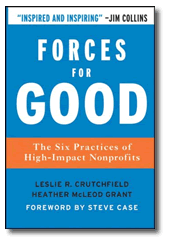Book Review: Forces for Good
Crutchfield, Leslie R. and Heather McLeod Grant. Forces for good : the six practices of high-impact nonprofits. Jossey-Bass, 2008.
Each day, my mother’s mailbox contains a dozen or so letters from nonprofits, soliciting financial support. She selects one or two to support and for the rest, she writes the date on the envelopes and files them chronologically in a box. In her basement, boxes of these letters date back to the 1970’s. She intends to support those organizations eventually — once she determines those that do the greatest good. But how to know which nonprofits have the greatest impact?
Forces for Good provides a rigorous and analytical look into extraordinary nonprofits and how they create large-scale social change. The authors surveyed thousands of nonprofit CEO’s and conducted more than 75 interviews to identify six practices that are essential for achieving significant results. For any non-profit, the secret to success is to mobilize outside groups, such as government and business, to be a force for good. Greatness has more to do with how nonprofits work outside the boundaries of their organizations than how they manage their own internal operations.
The book examines 12 extraordinary nonprofits to help answer the question: What makes great nonprofits great. Among the 12 extraordinary nonprofits are well-known organizations, such as Habitat for Humanity and Teach for America, as well as one non-profit located in Durham, Self-Help, a housing and economic development organization.
Research for Forces for Good was sponsored by the Fuqua School’s Center for the Advancement of Social Entrepreneurship.
© Reviewer: Meg Trauner & Ford Library – Fuqua School of Business. All rights reserved.
Tags: Social responsibility
